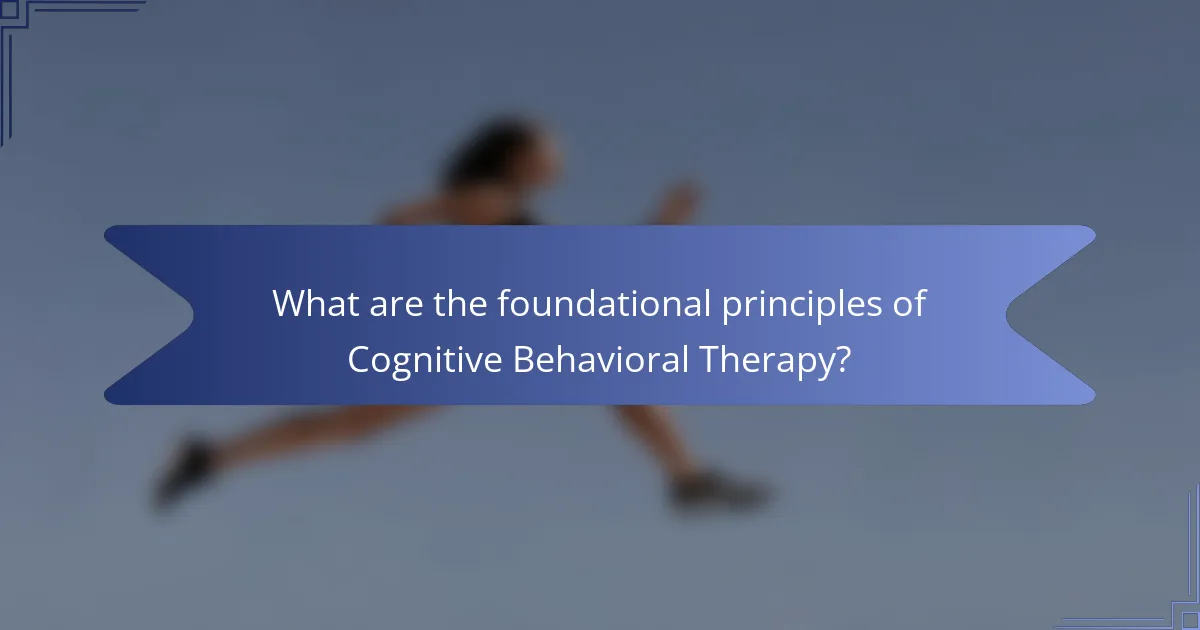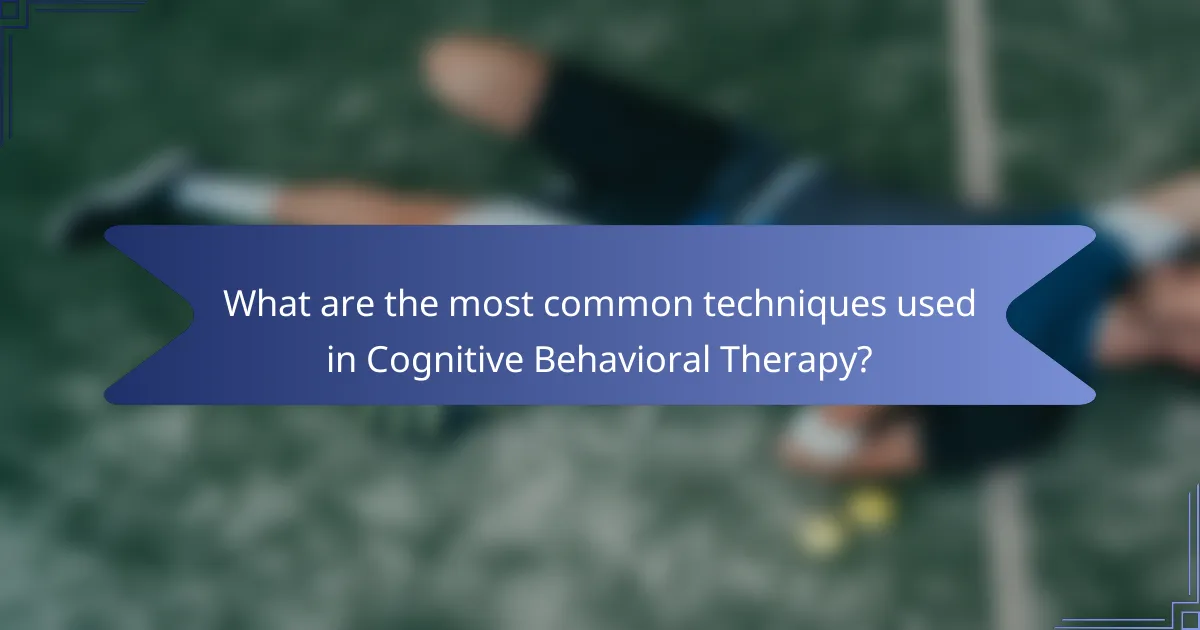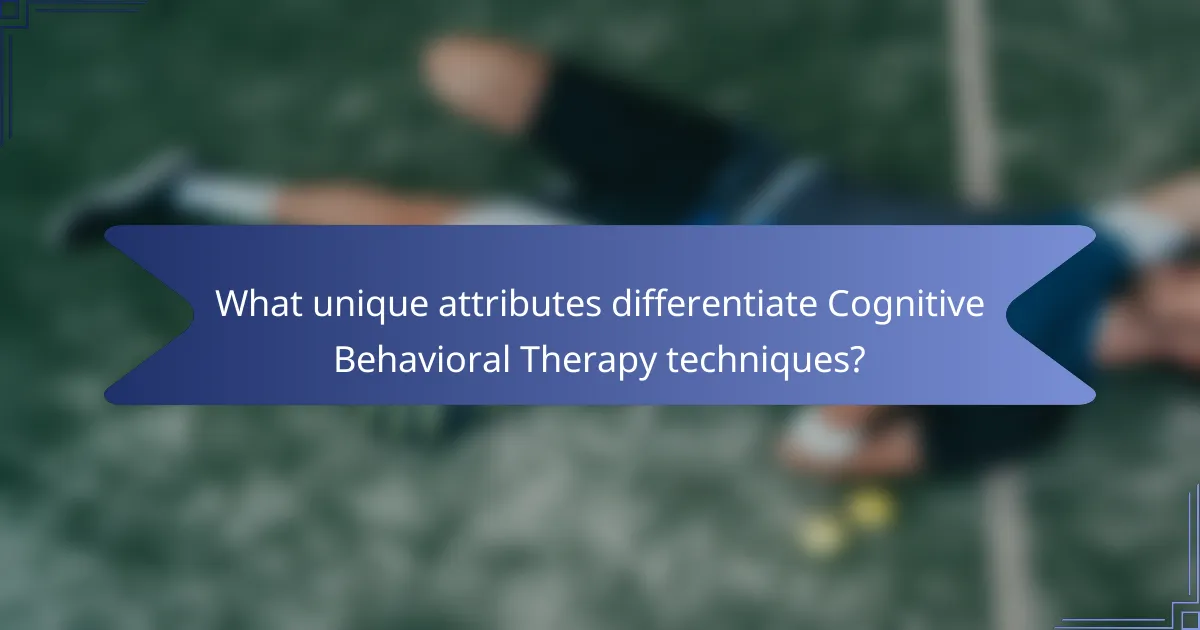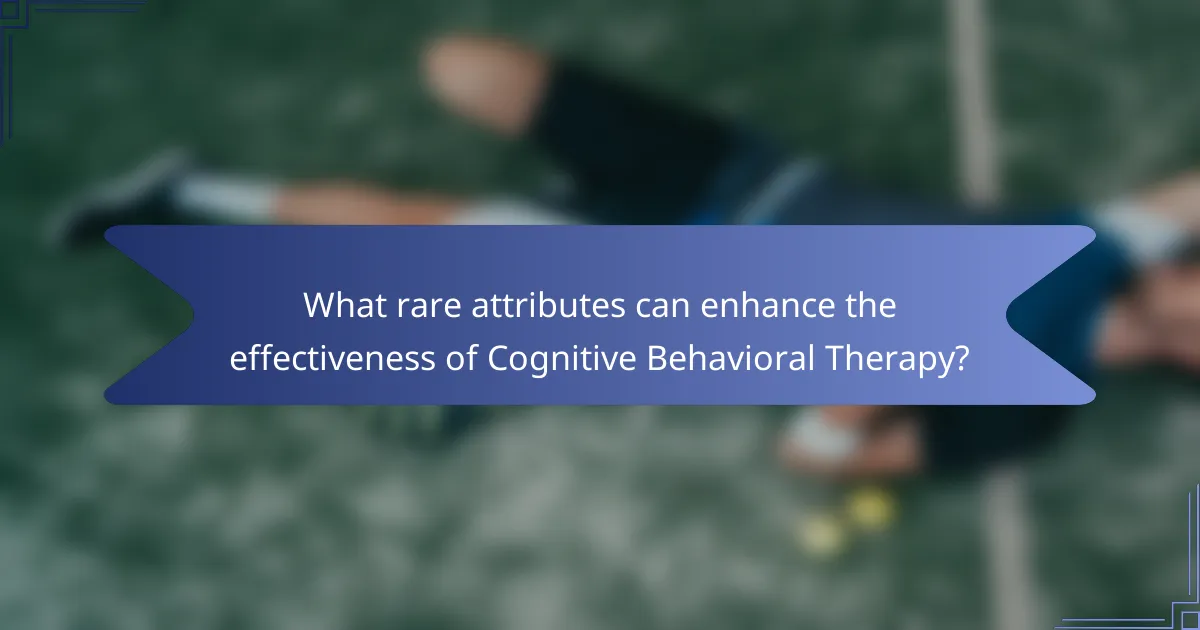Cognitive Behavioral Therapy (CBT) offers effective techniques for enhancing personal growth and emotional resilience. Key approaches include cognitive restructuring to challenge negative thoughts, behavioral activation to encourage positive activities, and exposure therapy to confront fears. Mindfulness practices further support emotional regulation. Understanding these methods can empower individuals to manage their thoughts and emotions effectively.

What are the foundational principles of Cognitive Behavioral Therapy?
Cognitive Behavioral Therapy (CBT) is grounded in principles that promote personal growth and emotional resilience. Key foundational principles include cognitive restructuring, which challenges negative thought patterns; behavioral activation, encouraging engagement in positive activities; and exposure therapy, gradually confronting fears. These techniques foster self-awareness and adaptive coping strategies, enhancing emotional well-being. CBT emphasizes the connection between thoughts, emotions, and behaviors, empowering individuals to create lasting change.
How does Cognitive Behavioral Therapy promote personal growth?
Cognitive Behavioral Therapy (CBT) fosters personal growth by equipping individuals with practical techniques for emotional resilience. It encourages self-awareness, enabling clients to identify and challenge negative thought patterns. This process promotes healthier thinking and behavior, leading to improved emotional regulation. Additionally, CBT enhances problem-solving skills, empowering individuals to navigate life’s challenges effectively. Studies show that clients often experience increased self-esteem and a greater sense of control over their lives after engaging in CBT, highlighting its role in personal development.
What role does Cognitive Behavioral Therapy play in building emotional resilience?
Cognitive Behavioral Therapy (CBT) enhances emotional resilience by teaching individuals to identify and challenge negative thought patterns. This process fosters healthier responses to stress and adversity. CBT techniques, such as cognitive restructuring and exposure therapy, empower individuals to develop coping strategies, leading to improved emotional regulation. As a result, participants often experience increased self-efficacy and a greater sense of control over their emotions and reactions.

What are the most common techniques used in Cognitive Behavioral Therapy?
Cognitive Behavioral Therapy employs various techniques to enhance personal growth and emotional resilience. Common techniques include cognitive restructuring, exposure therapy, behavioral activation, and mindfulness practices.
Cognitive restructuring helps individuals identify and challenge negative thought patterns, fostering a more positive mindset. Exposure therapy gradually exposes clients to feared situations, reducing anxiety over time. Behavioral activation encourages engagement in enjoyable activities, countering feelings of depression. Mindfulness practices promote present-moment awareness, enhancing emotional regulation and resilience. These techniques collectively empower individuals to manage their thoughts and emotions effectively.
How can cognitive restructuring improve thought patterns?
Cognitive restructuring enhances thought patterns by challenging negative beliefs and replacing them with positive alternatives. This technique fosters emotional resilience and promotes personal growth. It encourages individuals to identify cognitive distortions, such as overgeneralization or catastrophizing, and reframe these thoughts into more constructive perspectives. As a result, individuals experience reduced anxiety and improved overall mental well-being. Cognitive restructuring is a core component of cognitive behavioral therapy, which has been shown to be effective for various mental health issues.
What steps are involved in cognitive restructuring?
Cognitive restructuring involves several key steps to help individuals challenge and change negative thought patterns.
1. Identify negative thoughts and beliefs.
2. Evaluate the evidence for and against these thoughts.
3. Replace negative thoughts with more balanced, realistic ones.
4. Practice new thought patterns consistently.
5. Monitor progress and adjust strategies as needed.
These steps enhance emotional resilience and promote personal growth through cognitive behavioral therapy techniques.
What is the significance of exposure therapy in personal growth?
Exposure therapy is significant for personal growth as it helps individuals confront and manage their fears, leading to increased emotional resilience. This cognitive behavioral therapy technique allows for gradual exposure to anxiety-provoking stimuli, reducing avoidance behaviors. By facing fears, individuals can develop coping strategies, enhancing their overall mental health. Research indicates that consistent exposure can lead to long-term changes in thought patterns and emotional responses, fostering personal development and improved quality of life.
How is exposure therapy implemented effectively?
Exposure therapy is effectively implemented through gradual exposure to anxiety-provoking stimuli. This process typically follows a structured approach involving several key steps.
1. Assessment: Identify specific fears or anxieties.
2. Education: Explain the rationale behind exposure therapy.
3. Hierarchy Development: Create a fear hierarchy, ranking situations from least to most anxiety-inducing.
4. Gradual Exposure: Begin with less threatening scenarios, gradually increasing intensity.
5. Coping Strategies: Teach relaxation techniques to manage anxiety during exposure.
6. Reflection: Discuss experiences and feelings after each session to reinforce progress.
This systematic approach helps individuals build emotional resilience and confront fears in a controlled manner.
How does behavioral activation enhance emotional resilience?
Behavioral activation enhances emotional resilience by promoting engagement in meaningful activities. This approach encourages individuals to identify and participate in positive experiences, countering feelings of depression and anxiety. Engaging in such activities fosters a sense of accomplishment and improves mood. As a result, emotional resilience strengthens as individuals develop coping strategies and a more positive outlook on life. Research indicates that consistent practice of behavioral activation can lead to long-term emotional benefits, making it a valuable technique within cognitive behavioral therapy.

What unique attributes differentiate Cognitive Behavioral Therapy techniques?
Cognitive Behavioral Therapy techniques are distinguished by their focus on thought patterns, structured approach, and evidence-based practices. Unique attributes include personalized interventions, cognitive restructuring, and behavioral activation. These techniques emphasize the relationship between thoughts, emotions, and behaviors to foster personal growth and emotional resilience. Additionally, they often incorporate mindfulness strategies, which are less common in other therapeutic modalities, enhancing their effectiveness in managing anxiety and depression.
How do personalized treatment plans impact outcomes?
Personalized treatment plans significantly enhance outcomes in cognitive behavioral therapy by tailoring techniques to individual needs. This customization fosters deeper engagement and addresses unique emotional challenges, leading to improved resilience. Studies indicate that clients with personalized plans report higher satisfaction and better emotional regulation. This approach recognizes the unique attributes of each individual, ensuring therapy is relevant and effective.
What innovative techniques are emerging in Cognitive Behavioral Therapy?
Innovative techniques in Cognitive Behavioral Therapy (CBT) are enhancing personal growth and emotional resilience. One emerging approach is the integration of digital tools, such as mobile apps, that facilitate real-time tracking of thoughts and emotions. Another technique is the use of virtual reality to simulate anxiety-provoking situations, allowing clients to practice coping strategies in a controlled environment. Mindfulness-based CBT combines traditional CBT methods with mindfulness practices, promoting greater awareness and acceptance of thoughts and feelings. Additionally, the incorporation of neurofeedback is gaining traction, enabling clients to visualize brain activity and learn self-regulation techniques. These advancements reflect a shift toward more personalized and accessible therapeutic experiences.

What rare attributes can enhance the effectiveness of Cognitive Behavioral Therapy?
Incorporating rare attributes can significantly enhance the effectiveness of Cognitive Behavioral Therapy (CBT). Unique approaches such as integrating mindfulness practices can deepen emotional awareness. Specialized techniques like exposure therapy for specific phobias can lead to rapid progress. Tailoring CBT to individual cognitive styles can improve engagement and outcomes. Utilizing technology, such as apps for tracking progress, can provide real-time feedback and support.
How does integrating technology improve therapy outcomes?
Integrating technology significantly improves therapy outcomes by enhancing accessibility, personalization, and engagement. Digital tools like apps and teletherapy platforms provide immediate support, allowing clients to practice cognitive behavioral therapy techniques in real-time. This integration fosters emotional resilience and personal growth by enabling continuous tracking of progress and tailored interventions. Data analytics can identify unique patterns in behavior, offering insights that refine therapeutic approaches. As a result, technology empowers clients to take an active role in their mental health journey.
What unique cultural considerations should be taken into account?
Cognitive Behavioral Therapy techniques must consider cultural contexts to enhance effectiveness. Cultural beliefs, values, and communication styles influence individual perceptions of mental health.
Understanding these aspects is crucial for therapists. For example, collectivist cultures may prioritize family involvement in therapy, while individualistic cultures may emphasize personal autonomy.
Therapists should also be aware of unique attributes, such as stigma associated with mental health in certain cultures, which can affect a client’s willingness to engage in therapy.
Tailoring approaches to respect cultural nuances fosters trust and encourages open dialogue, ultimately leading to better outcomes in personal growth and emotional resilience.

How do regional perceptions influence the application of Cognitive Behavioral Therapy?
Regional perceptions significantly shape the application of Cognitive Behavioral Therapy (CBT) by influencing cultural attitudes toward mental health. Cultural beliefs can determine how individuals view psychological issues and their willingness to seek help. For instance, in collectivist societies, community and family dynamics may impact therapy engagement, while in individualistic cultures, personal responsibility is emphasized.
Moreover, language and expression of emotions vary across regions, affecting how clients articulate their experiences during therapy. CBT techniques may be adapted to align with local values, ensuring relevance and effectiveness. Understanding these regional nuances enhances therapists’ ability to foster emotional resilience and personal growth in diverse populations.
What are the common misconceptions about Cognitive Behavioral Therapy in different cultures?
Cognitive Behavioral Therapy (CBT) misconceptions vary across cultures, often leading to misunderstandings about its effectiveness. Many believe CBT is only about positive thinking, neglecting its structured approach to addressing negative thought patterns. Some cultures may view mental health issues as weaknesses, discouraging individuals from seeking therapy. Additionally, there is a misconception that CBT is a quick fix, while it actually requires time and effort for lasting change. Lastly, cultural stigma around therapy can hinder acceptance of CBT, as it may be seen as a sign of personal failure rather than a constructive tool for emotional resilience.
How do local mental health resources affect access to Cognitive Behavioral Therapy?
Local mental health resources significantly enhance access to Cognitive Behavioral Therapy (CBT). They provide essential support systems, making therapy more approachable and tailored to community needs.
Access to local resources can reduce barriers such as transportation challenges and financial constraints. Many community centers offer affordable or free CBT sessions, increasing participation rates. Additionally, local resources often facilitate connections between clients and therapists who understand regional cultural contexts, enhancing therapeutic effectiveness.
Research indicates that individuals with access to local mental health services are more likely to engage in CBT, leading to improved emotional resilience and personal growth. This accessibility is crucial for fostering a supportive environment where individuals can thrive.

What best practices should be followed for effective Cognitive Behavioral Therapy?
Effective Cognitive Behavioral Therapy (CBT) requires adherence to several best practices. First, establish clear therapeutic goals to guide the process and measure progress. Second, utilize cognitive restructuring techniques to challenge negative thought patterns. Third, practice exposure exercises to confront and reduce anxiety related to specific fears. Fourth, maintain a consistent session schedule to build a strong therapeutic alliance. Finally, encourage self-monitoring through journaling to enhance self-awareness and track emotional responses. These practices foster personal growth and emotional resilience.
What are the most common mistakes to avoid in Cognitive Behavioral Therapy?
Common mistakes in Cognitive Behavioral Therapy include neglecting homework assignments, focusing excessively on thoughts without addressing emotions, failing to establish clear goals, and not personalizing techniques to fit individual needs. These errors hinder personal growth and emotional resilience, reducing the therapy’s effectiveness. Addressing these mistakes can enhance the therapeutic process and outcomes.
How can individuals optimize their experience with Cognitive Behavioral Therapy?
To optimize the experience with Cognitive Behavioral Therapy (CBT), individuals should actively engage with techniques that promote personal growth and emotional resilience. Practicing self-monitoring enhances awareness of thoughts and behaviors. Setting specific, measurable goals aids in tracking progress. Implementing cognitive restructuring helps challenge negative thought patterns. Regularly utilizing exposure techniques can reduce anxiety through gradual desensitization. Additionally, maintaining a journal fosters reflection and reinforces learning from therapy sessions.